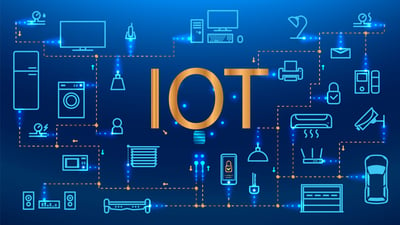Industry 4.0 is one of the most commonly used jargons in technology arena these adays. The fourth industrial revolution in manufacturing industry is referred as Industry 4.0 and is defined as a set of digital technological shifts to create a consistent framework in the manufacturing sector. It is the integration of smart digital technology and manufacturing, and places an emphasis on automation, machine learning and real-time data. This revolution is driven by the need to access real-time insights and information across the manufacturing process.
 In other words, Industry 4.0 is the application of the Internet of Things (IoT), cloud computing, cyber-physical systems (CPS), and cognitive computing into the manufacturing and service environment. It is an extension of Industry 3.0, where computers were introduced into the manufacturing process. Industry 4.0 focuses on connecting those computers to one another. However, Industry 4.0 goes far beyond systems on the factory floor being able to communicate with one another. When fully applied, Industry 4.0 allows for the creation of smart factories and enables digital manufacturing.
In other words, Industry 4.0 is the application of the Internet of Things (IoT), cloud computing, cyber-physical systems (CPS), and cognitive computing into the manufacturing and service environment. It is an extension of Industry 3.0, where computers were introduced into the manufacturing process. Industry 4.0 focuses on connecting those computers to one another. However, Industry 4.0 goes far beyond systems on the factory floor being able to communicate with one another. When fully applied, Industry 4.0 allows for the creation of smart factories and enables digital manufacturing.
History
Industry 4.0 is the most recent of the four diverse industrial revolutions that the world has experienced:
The First Industrial Revolution: Began in the 1760s and was referred as the age of mechanical production. Water and steam mechanization came into picture, which were advancements compared to manual labour for increased output and rudimentary optimised manufacturing.
The Second Industrial Revolution: With the introduction of steel and electricity in factories, the second industrial revolution began in the 1870s – which is also referred to as the age of Science & Mass Production. This resulted in the creation of mass production concepts such as the assembly line that broke down complex manufacturing into simple specific tasks.
The Third Industrial Revolution: Referred as Digital Age that began in the early 1950s when electronic technology was introduced to manufacturing processes and switched from analogue to digital technology. Mass production of transistors and integrated circuit pieces were key to this evolution as this made automation more accessible.
Industry 4.0: Started its journey in 2011, which was also termed as the Technological Age, this Fourth Industrial Revolution builds upon the foundation of the digital revolution, but with a whole new level of interconnectedness through the use of IoT. This new wave of smart manufacturing uses access to real-time data to boost productivity and output, increase efficiency and create what is known as a smart factory. This goes one step further in some cases, where organisations are utilising augmented reality and artificial intelligence to go one step further.
Applications of Industry 4.0
Industry 4.0 can be applied to every phase of product lifecycle in the manufacturing process. In addition, Industry 4.0 can also be applied to external resources such as supply chains, thereby, enabling them to better anticipate supply disruptions, while also making it easier to source all of the materials used in the manufacturing of a product. Further, in order to process and analyse the real-time data in manufacturing, Industry 4.0 has been widely used. This can enhance efficiency and reduce the time to market, while also increasing the organization's productivity.
Technologies driving Industry 4.0
Industry 4.0 is built on nine technology towers. Businesses and supply chains have already been using few of these advanced technologies but the full potential of Industry 4.0 comes to fruition when they’re used together. Industry 4.0 is driven by the conjunction of technologies, including the following:
- IIoT: the Industrial Internet of Things (IIot) and IoT in Industry 4.0 are often used interchangeably. Devices, robots, machinery, equipment and products in Industry 4.0 use sensors and RFID tags to provide real-time data about their condition, performance, or location. This technology enables organizations run smoother supply chains, rapidly design and modify products, prevent equipment downtime, stay on top of consumer preferences, track products and inventory.
- Cloud Computing: Cloud technologies continue to get faster and more powerful. Businesses will increasingly deploy machine data and analytics to the cloud, thus, enabling more data-driven services for production systems.
- Big data and analytics: In Industry 4.0, Big Data is collected from a wide range of sources, from factory equipment and IoT devices to ERP and CRM systems, to weather and traffic apps. Analytics powered by artificial intelligence (AI) and machine learning are applied to the data in real time – and insights are leveraged to improve decision-making and automation in every area of supply chain management: supply chain planning, logistics management, manufacturing, R&D and engineering, enterprise asset management (EAM), and procurement.
- Digital Twin: A digital twin is a virtual simulation of a real-world machine, product, process, or system based on IoT sensor data. This core component of Industry 4.0 allows businesses to better understand, analyse, and improve the performance and maintenance of industrial systems and products.
- Cybersecurity: With the increased connectivity and use of Big Data in Industry 4.0, effective cybersecurity is paramount. By implementing a Zero Trust architecture and technologies like machine learning and blockchain, companies can automate threat detection, prevention and response and minimize the risk of data breaches and production delays across their networks.
- Horizontal and Vertical Integration: Horizontal and vertical integration are the backbone of Industry 4.0 is, wherein processes are tightly integrated at the “field level” in horizontal integration and all the layers of an organization are tied together in vertical integration
- Augmented reality systems: Augmented reality systems, which overlays digital content on a real environment, support a variety of services, such as selecting parts in a warehouse and sending repair instructions over mobile devices. With AR, companies can provide workers with real-time information that improves decision making and work procedures
- Advanced robotics: With Industry 4.0, a new generation of autonomous robots are evolving. Programmed to perform tasks with minimal human intervention, autonomous robots interact with one another and work safely side by side with humans. These robots will cost less and have an increasing range of capabilities over time
- Additive manufacturing: Additive manufacturing or 3D printing is another key technology driving Industry 4.0, with which parts and small batches of customized products can be stored as design files in virtual inventories and printed on demand at the point of need.
Challenges of Industry 4.0
- Cost and interoperability are the key challenges for business intending to adapt industry 4.0. It is difficult to establish communication between connected devices as machines and sensors used in manufacturing units rely on several set of protocols. However, as businesses are greatly adapting Industry 4.0, industry standards have been strongly placed.
- Cybersecurity: Unlike the past, as the systems on the factory floor are connected to one another or to back-end IT systems, the connectivity may expose these devices to the cyber threats.
- Support from the team: Implementing new technology and a new business model can be hard for some people to accept and adopt, and getting support from the team is big challenge for business investing in Industry 4.0 technology.
Benefits of Industry 4.0
Though there are challenges in adapting Industry 4.0, adapting to it provides numerous benefits to organizations:
- Enables OEMs to observe the customer’s usage of the product versus customer’s requirement.
- Sensor data helps organizations to monitor the manufacturing process in real time, consequently, helps determine where the process could be improved.
- Industry 4.0 principles help organizations avoid an outage on the factory floor. However, Industry 4.0 has enabled machinery to be equipped with sensors that monitor the machinery's health on an ongoing basis. This enables organizations to anticipate problems before they occur and proactively take corrective action. In some cases, the machinery can even automatically place an order for replacement parts. All this together can help an organization avoid a costly outage that disrupts the manufacturing process.
- Because the digital technology used on the factory floor is tied to back-end corporate data systems, it allows big data analytics to be performed on the data that is associated with the manufacturing process. Such analytics can help the organization spot trends and gain insights that might ultimately help it become more profitable.
- Radical improvements in productivity and automation: Businesses are making data-driven decisions across their operations, improving forecast accuracy, supporting on-time delivery and building profit-optimized plans.
- Resilience and agility, no matter what the market or economy bring: Companies are shaping the future digital supply chain based on state-of-the-art planning.
- Confidence to explore new business models and seize opportunities quickly: Thanks to Industry 4.0 solutions, businesses are reducing costs, improving market efficiency, and connecting supply chains by sea, land and air.
- Green and sustainable solutions without sacrificing profitability: Customers are becoming more efficient and cost-effective by going digital – while meeting their environmental objectives without compromising on other business goals, such as profitability and scalability.
Our Industry 4.0 Offerings
ACI Infotech’s Industry 4.0 consulting services take a complete, ecological, and mountable approach. We deliver by deploying proprietary tools and methodologies developed in our Innovation Centre for Operations infrastructure. These offerings cover every manufacturing domain and comprise advanced manufacturing technologies that are empowered through data progression, storage, and optimization.
Our IoT-enabled products have touched every aspect of our lives. Whatever your industry and whatever customers you serve, the key to succeeding in the new world of digital is getting your best ideas to market. That means having a business case for IoT, as well as the right resources in place to move quickly and deliver value. Our team can help you identify and realize opportunities along the path, from idea to market—while navigating the complexities of today’s rapidly evolving technologies.



